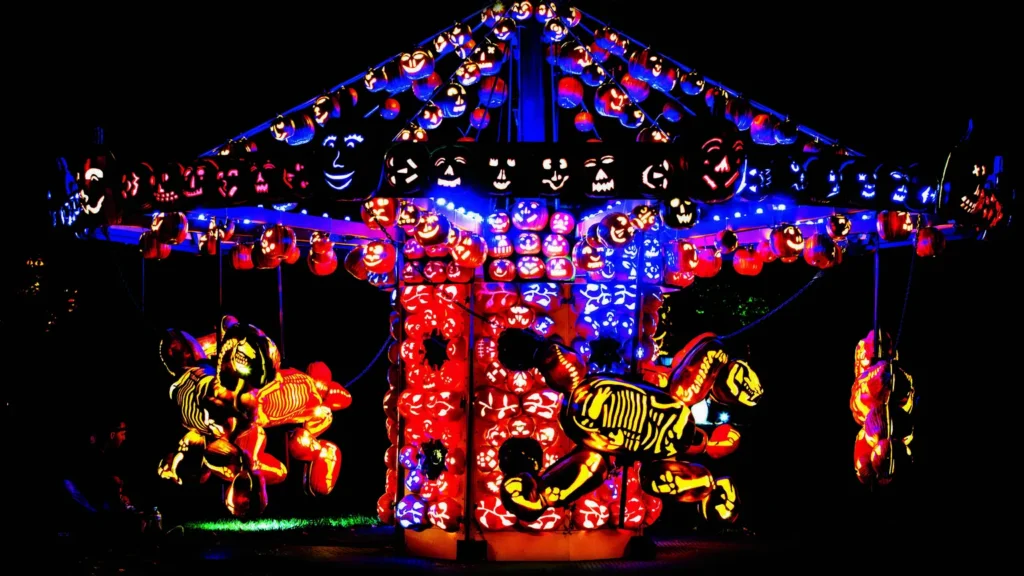Every fall, artists and enthusiasts alike gather for one of the most iconic seasonal events in the United States: the Great Jack-O-Lantern Blaze. Held in various locations across New York, this event is a true celebration of artistry, craftsmanship, and creativity, where thousands of pumpkins are meticulously carved to create a mesmerizing, immersive experience. With its roots in both historical tradition and modern creativity, the Blaze has become an annual pilgrimage for many, drawing crowds that span generations and backgrounds. However, as with any event that has achieved such fame, it comes with its share of critiques and challenges.
In this extensive critique, we will explore the artistic value of the Great Jack-O-Lantern Blaze, analyze its impact on the community and culture, and delve into the intricacies of pumpkin carving as both a craft and an art form. We will also provide insights from professional pumpkin carvers, offering tips for those who are inspired by the Blaze and wish to elevate their own carving skills.
The Artistic Value of the Great Jack-O-Lantern Blaze
At its core, the Great Jack-O-Lantern Blaze is a celebration of creativity. Each year, artists carve thousands of pumpkins to form an expansive, illuminated landscape that transforms venues into eerie and magical realms. These pumpkins are not just the simple jack-o’-lanterns we carve at home; they are intricate, often thematic works of art, spanning subjects from animals and famous landmarks to elaborate patterns that seem to defy the limitations of pumpkin flesh.
The craftsmanship on display at the Blaze is truly extraordinary. Each pumpkin is treated as a unique canvas, with carvers using an array of tools and techniques to create complex designs. Some carvers rely on traditional carving methods, using knives and chisels to cut through the pumpkins’ thick skin. Others employ more modern techniques, such as etching and shading, to give their pumpkins depth and detail. The results are pumpkins that appear to glow from within, their intricate patterns and designs illuminated by the flickering candlelight.
One of the most impressive aspects of the Great Jack-O-Lantern Blaze is the sheer scale of the event. With thousands of pumpkins on display, the event has a truly immersive quality. The pumpkins are arranged in elaborate displays, often grouped by theme or design, to create a cohesive and visually striking experience. In one section, for example, visitors may find a towering pumpkin “spider,” its limbs stretching out into the night sky. In another, they may encounter a meticulously carved representation of the Statue of Liberty, its iconic features recreated in glowing orange light. The scale of these displays is a testament to the hard work and dedication of the artists who create them, many of whom spend months planning and preparing for the event.
However, while the artistic value of the Blaze is undeniable, it also raises questions about the nature of art itself. Some critics argue that pumpkin carving, despite its beauty, is a transient form of art. After all, pumpkins are perishable, and no matter how intricate the carvings, they will eventually rot and decay. Is it fair, they ask, to invest so much time and energy into something so fleeting? Others, however, argue that this impermanence is precisely what makes the art of pumpkin carving so powerful. Like sand sculptures or ice carvings, the pumpkins at the Blaze are a reminder of the transient nature of beauty, and of life itself.
Cultural Impression and Community Involvement
The Great Jack-O-Lantern Blaze has grown from a local event into a significant cultural phenomenon. Thousands of people flock to the event each year, making it a beloved tradition for many families. It represents a moment where art, community, and tradition intersect, offering an opportunity for people to celebrate both the spooky and festive elements of the fall season. The event is an excellent example of how local art can foster a sense of community and bring people together, which is particularly important in an increasingly digital world where tangible, shared experiences are becoming rare.
On a cultural level, the event also taps into the broader history of Halloween and the tradition of jack-o’-lanterns. The tradition of carving pumpkins can be traced back to an old Irish legend about a man named Stingy Jack, who tricked the Devil and was condemned to roam the Earth with only a carved-out turnip to light his way. When Irish immigrants brought this tradition to America, they found that pumpkins, which were native to the New World, made an even better canvas for their lanterns. The Great Jack-O-Lantern Blaze, in a sense, pays homage to this history while elevating it to the level of high art.
That said, there are critiques regarding the commercialization of the event. As the Blaze has grown in popularity, it has also become more expensive and crowded. Some locals feel that the event has lost some of its original charm, becoming more of a tourist attraction than a community gathering. Additionally, the mass production of carved pumpkins for the event has raised concerns about sustainability. Pumpkins, after all, are a food crop, and the use of thousands of them for artistic purposes, rather than for consumption, has led some to question the environmental impact of the Blaze.
Pumpkin Carving as an Art Form: From Amateur to Professional
Pumpkin carving has come a long way from its humble origins as a fun Halloween activity. At the Great Jack-O-Lantern Blaze, it is elevated to an art form, with professional carvers and artists pushing the boundaries of what can be achieved with a simple pumpkin. The level of detail and intricacy in some of the carvings is truly astonishing. From multi-layered etchings to three-dimensional sculptures, the pumpkins at the Blaze demonstrate the incredible versatility of this medium.
However, despite the artistry on display, pumpkin carving is still often viewed as a lesser form of art, perhaps due to its seasonal and impermanent nature. Professional pumpkin carvers, who spend years honing their craft, face the challenge of being recognized as legitimate artists. Yet, their work requires not only creativity but also technical skill and precision. Working with pumpkins presents unique challenges: the medium is fragile, and carvers must be mindful of its structural limitations. The skin of a pumpkin is tough, but the flesh inside is soft and prone to collapse if too much is carved away.
For those looking to improve their pumpkin-carving skills, there are a few professional tips to keep in mind:
Choose the Right Pumpkin: The shape and size of your pumpkin will affect your design. A round, symmetrical pumpkin is ideal for more traditional designs, while an irregularly shaped pumpkin can be used to create more dynamic or unique pieces.
Use the Right Tools: Professional carvers use a variety of tools, from specialized knives and chisels to etching tools for more detailed work. Invest in a good set of carving tools if you want to take your pumpkin carving to the next level.
Plan Your Design: Before you start carving, it’s essential to plan your design. Some carvers sketch their designs directly onto the pumpkin, while others use stencils. Either way, having a clear plan will help ensure that your final product is polished and professional.
Consider Depth: Not all pumpkin carving has to be about cutting all the way through the flesh. By carving at different depths, you can create shading and depth in your design. This technique is particularly useful for more intricate, three-dimensional carvings.
Preservation: One of the biggest challenges of pumpkin carving is the inevitable decay. To prolong the life of your carved pumpkin, you can coat the exposed areas with petroleum jelly, which helps to seal in moisture and prevent rot. There are also commercial pumpkin preservation sprays available.
One of the most significant critiques of the Great Jack-O-Lantern Blaze is the question of sustainability. With thousands of pumpkins being used each year, many wonder about the environmental and ethical implications of such a large-scale event. Pumpkins are, after all, a food crop, and there is a growing awareness of food waste and its impact on the environment.
However, the organizers of the Blaze have made efforts to address these concerns. Most of the pumpkins used for the event are locally sourced, and after the event is over, the pumpkins are composted. This helps to reduce the environmental impact of the event and ensures that the pumpkins do not go to waste. Additionally, many of the more intricate displays at the Blaze are made using artificial pumpkins, which can be reused year after year. While this does reduce the overall number of real pumpkins used, it also raises questions about the authenticity of the event. After all, part of the charm of the Blaze lies in the fact that the pumpkins are real and ephemeral, much like the fall season itself.
The Great Jack-O-Lantern Blaze is a remarkable event that combines art, tradition, and community in a unique and visually stunning way. The level of artistry on display is truly impressive, and the event has become a beloved tradition for many. However, it is not without its challenges. The commercialization of the Blaze, concerns about sustainability, and the transient nature of pumpkin carving all raise important questions about the role of art in our society.
Ultimately, the Great Jack-O-Lantern Blaze serves as a reminder of the power of creativity and community. It brings people together, allows them to experience art in a new and exciting way, and provides an opportunity to celebrate the beauty of the fall season. While the pumpkins may eventually rot away, the memories created at the Blaze will last a lifetime.
No comments yet.








